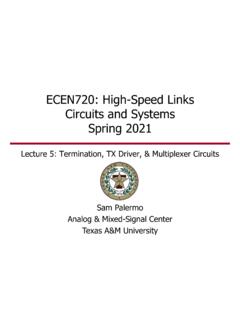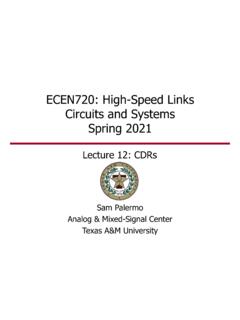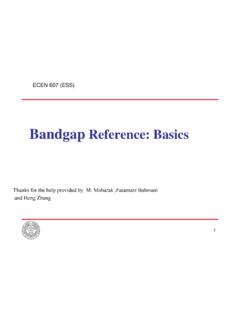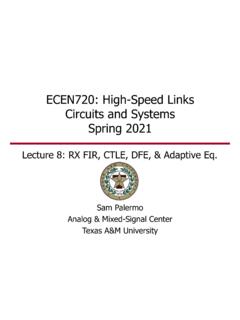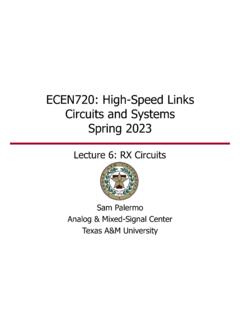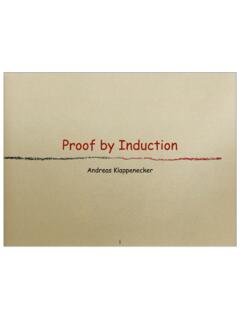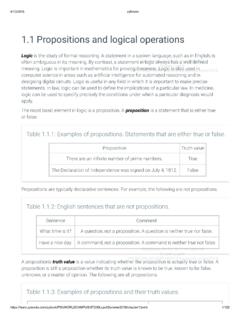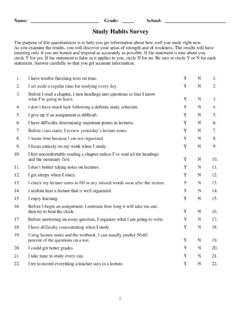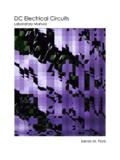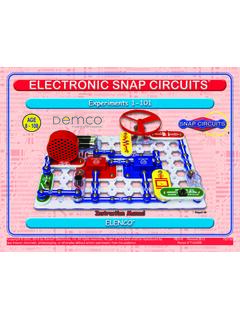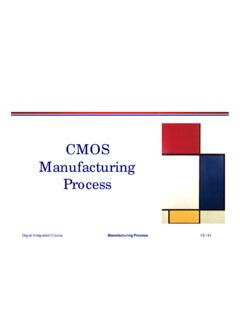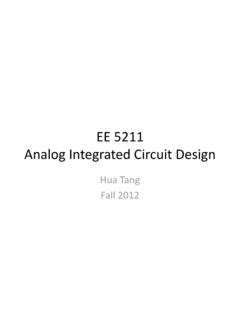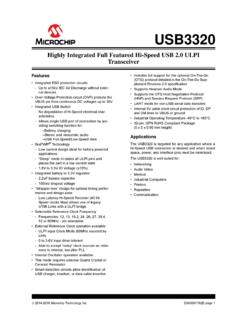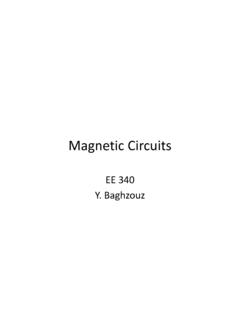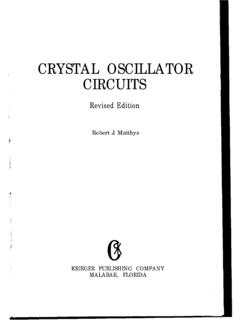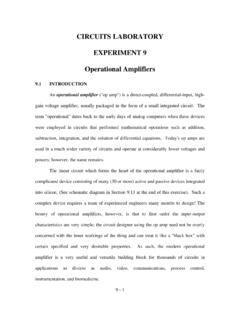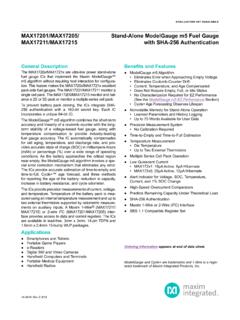Transcription of OPERATIONAL AMPLIFIERS: Basic Circuits and Applications
1 Texas A & M UniversityEdgar Sanchez-Sinencio, ELEN 457 OPERATIONALAMPLIFIERS:BasicCircuits and ApplicationsECEN 457 (ESS)Texas A & M UniversityEdgar Sanchez-Sinencio, ELEN 457 Outline of the course Introduction & Motivation OP Amp Fundamentals Circuits with Resistive Feedback Basic Operators: Differential, Integrator, Low Pass Filters Static Op Amp Limitations Dynamic Op Amp Limitations Noise Nonlinear Circuits Signal Generators Voltage Reference and Linear Regulators OPERATIONAL Transconductance Amplifier Analog MultipliersTexas A & M UniversityEdgar Sanchez-Sinencio, ELEN 457 BRIEF OP AMP HISTORY3-The OPERATIONAL Amplifier(op amp) was invented in the 40 s. Bell Labs filed a patent in 1941 and many consider the first practical op amp to be the vacuum tube K2-W invented in 1952 by George Instruments invented the integrated circuit in 1958 which paved the way for Bob Widlarat Fairchild inventing the uA702 solid state monolithic op amp in 1963. -But it wasn t until the uA741, released in 1968, that op amps became relatively inexpensive and started on the road to ubiquity.
2 And they didn t find their way into much consumer audio gear until the late 70 s and early 80 A & M UniversityEdgar Sanchez-Sinencio, ELEN 457 WHERE DO YOU USE OP AMP? Audio Amplifiers Low Dropout Regulators Active Filters Medical Sensor Interfaces Baseband Receivers Analog to Digital Converters Oscillators Signal Generators Hearing Aids 4 Texas A & M UniversityEdgar Sanchez-Sinencio, ELEN 457 What is an amplifier?An amplifier is a device that increases its input by a certain quantity, passing through it, called gain. How many types of amplifier exist? Voltage Controlled Voltage Source (VCVS) Voltage Controlled Current Source (VCIS) Current Controlled Current Source (ICIS) Current Controlled Voltage Source (ICVS) The most popular amplifiers are the Op Amp (VCVS) and the Transconductance (VCIS).5 Texas A & M UniversityEdgar Sanchez-Sinencio, ELEN 457 Are all the Op Amps connected in closed loop? Majority of Applications use the Op Amp in closed loops. Op Amps might be used in open loop as comparators.
3 The transconductance amplifiers is typically used in closed loop for switched-capacitor Circuits . The transconductance amplifiers are often used in open loop for continuous-time filters. (Gm-C filters) Where do you use transconductance amplifier (VCIS) or current amplifier (ICIS) amplifiers? In continuous-time current-mode filters. Sensor interface as a pre-conditioning low noise A & M UniversityEdgar Sanchez-Sinencio, ELEN 457 Section 11)Op Amp fundamentals and ideal macromodelV2+-V1 Vout AVout V1V2+-A(V1-V2)Op Amp macromodel with ideal parameters except finite voltage gain ATexas A & M UniversityEdgar Sanchez-Sinencio, ELEN 457Op Amp FundamentalsDifferent Amplifier Types :2. Current Amplifier1. Voltage Amplifier3. Trans-conductance Amplifier4. Trans-resistance AmplifierInputOutputAmplifier TypeGainRiRoVIVoVoltageV/V 0iIioCurrentA/A0 VIIoTransconductanceA/V IIVoTransresistanceV/A00 Texas A & M UniversityEdgar Sanchez-Sinencio, ELEN 457Op Amp FundamentalsThe OPERATIONAL Amplifier : Op Amp is a voltage amplifier with extremely high gain (741, Gain: 200,000 (V/V), Op-77, Gain: 12 (V/uV) rd, a, roare open-loop parameters vP: Non-inverting vN: Inverting v0 = a.
4 VD= a (vP vN)The Ideal Op Amp: The virtual input short does not draw any current For voltage purposes: Input appears as a short circuit For current purposes:Input appears as an open circuitTexas A & M UniversityEdgar Sanchez-Sinencio, ELEN 457Op Amp Fundamentals The Voltage Follower (Unity Gain Amplifier) Basic Op Amp Configurations : Non-inverting Amplifier A resistance transformer The source does not deliverany current to load a is the open loop gain of the Op AmpTexas A & M UniversityEdgar Sanchez-Sinencio, ELEN 457 Input and Output Impedances computation NIinZinVinLoadZin = Vin/IinNIoutZoutVoutInput sourceimpedanceZout= Vout/IoutApply a test current source at the input(output) and measure the corresponding voltage across the current source while making zero all the independent sources Texas A & M UniversityEdgar Sanchez-Sinencio, ELEN 457Op Amp Fundamentals The Summing Amplifier ( Popular Application : Audio Mixing ) Basic Op Amp Configurations : Inverting AmplifierThe output is the weighted sum of the inputsTexas A & M UniversityEdgar Sanchez-Sinencio, ELEN 457Op Amp FundamentalsBasic Op Amp Configurations : The Difference Amplifier ( Popular Application : Instrumentation ).
5 Note that the sum of conductancesat the positive and negative input terminal are equal. Verify that. The Differentiator Without Rs the circuit tends to oscillate By putting the Rs in series withC, the oscillation problem is solved The circuit still provides differentiation function over the limited bandwidthTexas A & M UniversityEdgar Sanchez-Sinencio, ELEN 457Op Amp FundamentalsBasic Op Amp Configurations : The Integrator (Popular Applications : Function generators, Active filters, A/Ds, Analog (PID) controllers ) The Negative Resistance Converter (NIC) Due to the input offset error of the op ampthe output drifts until it saturates at thevalue close to one of the supplies. By putting Rp in parallel with C, we can prevent saturation and have integration over a limited bandwidth. Current is floating toward the source Negative resistance releases the power. Applications :1) Neutralization of unwanted resistances in the design of current source2) Control pole location (Oscillators)Texas A & M UniversityEdgar Sanchez-Sinencio, ELEN 457 Remarks on inverter or non-inverting amplifier configurations Z1 ZFVoAV1V2 AVVo2 1F21F1F11 FoZZ1A11 VZZ1ZZ1A11 VZZVFor V2=0 and ideal infinite A, then Vo/V1 becomes:Vo/V1 = -ZF/Z1 Where the impedance can be any passive component R or C or a combination of connection of these two components.
6 Examples are the differentiator, integrator, first-order low pass, high pass among many A & M UniversityEdgar Sanchez-Sinencio, ELEN 457Op Amp FundamentalsNegative Feedback; A Systematic Approach :Building Blocks outputs:1)Error Amplifier; 2)Feedback Network;3)Summing Network; Price for a tight closed loop accuracy : a >> A The smaller the closed-loop is, the smaller the percentage from deviation A & M UniversityEdgar Sanchez-Sinencio, ELEN 457Op Amp parameter characterizationFeedback Properties :1) Gain De-sensitivity2) Nonlinear Distortion Reduction3) Effect on Disturbance and Noise The negative feedback desensitizes the open loop gain Components in bshould have verygood quality As long as ais sufficiently large and to make T >> 1 , A will be fairlyconstant and close to 1/b in spit of the decrease of a away from the originTexas A & M UniversityEdgar Sanchez-Sinencio, ELEN 457 Negative Feedback Op Amp FundamentalsFeedback in Op Amp Circuits :Negative feedback topologiesInput Series FBInput Shunt FBOutput Shunt FBOutput Series FB Input + Feedback enter the amplifier at different nodes: Input Series FB Input + Feedback enter the amplifier at the same nodes.
7 Input Shunt FB If we short the output load and still there is FB signal at the input: Output Series FB If we short the output load and still there is FB signal at the input: Output Series FBAT THE INPUT/OUTPUT PORT, A SERIESTOPOLOGY RAISESAND A SHUNTTOPOLOGY LOWERSTHE CORRESPONDING PORT RESISTANCET exas A & M UniversityEdgar Sanchez-Sinencio, ELEN 457 Feedback Op Amp FundamentalsAnalysis of Basic Op Amp Configurations Using Feedback Theory : Non-inverting Amplifier(Input Series Output Shunt FB) Non-inverting Amplifier(Input Shunt Output Shunt FB)Texas A & M UniversityEdgar Sanchez-Sinencio, ELEN 457Op Amp Loop Gain Computation Finding the Loop Gain (T) Directly: Suppress all inputsources, Break the loop at some convenient point Inject the test signal (vT) Find the return signal (vR) at the breaking point using the feedback path:Finding the Feedback Factor (b) Directly: Suppress all inputsources, Disconnect the op amp Replace the op amp with its terminal resistances (rd, ro) Apply a test source vTvia ro, find the difference voltage vDacross rd, then:By finding b, using datasheet we can find a and calculate T = a.
8 BTexas A & M UniversityEdgar Sanchez-Sinencio, ELEN 457Op Amp Powering Op Amp Powering: mF capacitance:1) Prevents the AC noise coming from non-zero impedance betweenthe supply and the ) Neutralizes spurious feedback loops arising from non-zeroImpedance between the supply andground. 10 mF capacitance provides board-level by pass. Using wide ground traces is recommended. VCCand VEEcan be dual +15V , -15V supplies (analog systems), or single 5 V and zero supply (mixed-mode Applications )Texas A & M UniversityEdgar Sanchez-Sinencio, ELEN 457Op Amp I-O Piecewise linear approximationOp Amp Powering: VCCand VEE set upper and lower bounds on the output swing capacity1)Linear Region; a = V/mVModel: dependent source2)Positive Saturation Region;VoH remains )Negative Saturation Region;V oLremains fixed. Bipolar op amps: VoH ~ VCC 2 V, VoL~ VEE 2 V CMOS op amps: VoH~ VCC, VoL~ VEE Common characteristic of saturating amplifier: Clipped output voltage Undesirable in many cases.
9 Application : POP MUSIC FUZZ BOXES
